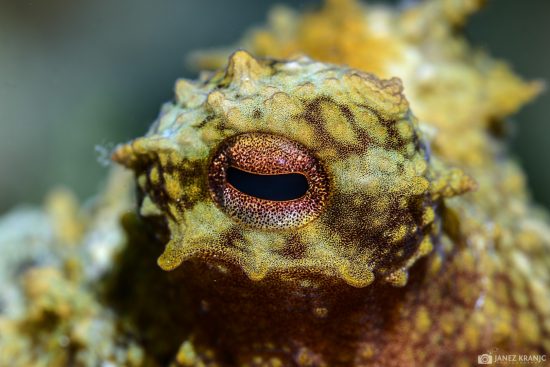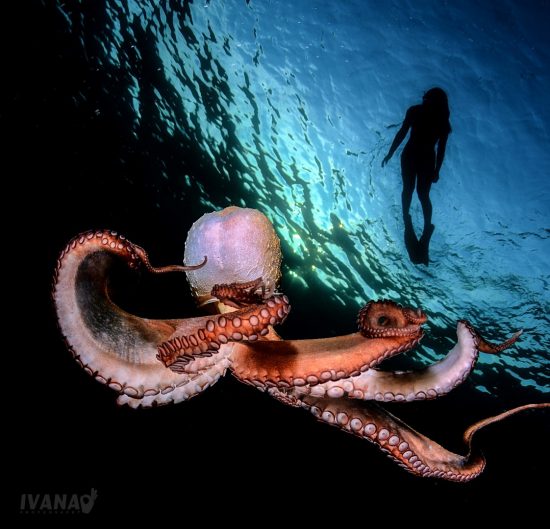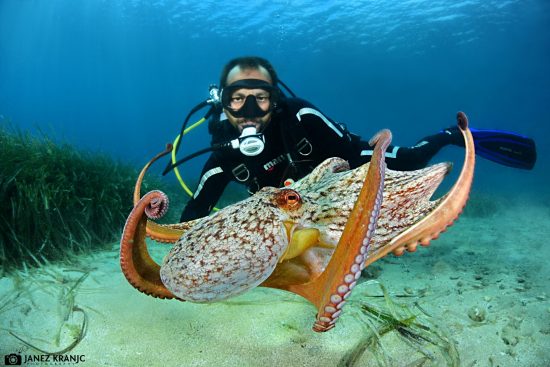





Who doesn’t like octopuses? They have it all: beautiful, smart and unique. These molluscs are part of the ‘Octopoda’ (eight limbs) order and are widely distributed around the world’s oceans, living at different temperatures and depths. Often associated with warm waters, they are seen in the shallows by swimmers and divers, but they also known to occupy cold, deep waters.
Octopuses share the Cephalopod class with squid, cuttlefish and nautilus, but they are the most intelligent and thought to be the most developed invertebrates, with a highly specialised nervous system and a large centralised brain. Most of their neurons are not localised in the brain but distributed around their arms meaning they have excellent control of their tentacles and suckers.
Their skin is lined with chromatophores which are responsible not only for their amazing ability to change colour to blend in with their surroundings, but also texture. It is directly connected to their nervous system.
They are very sociable animals and are known to show shoaling behaviour with fish. They can detect gravity using statocysts and use their arms for tactile exploration. They can crawl along the sea bed using their arms and are very dexterous – they are even able to open jars and manoeuvre themselves out of trouble through tiny spaces.
Octopuses come in different shapes, colours and sizes depending on the environment in which they live. Soft-bodied, they are tough and have no skeleton, allowing them to squeeze through the smallest, narrowest spaces either while hunting or escaping from a predator. The smallest octopus is tiny, at 5cm, with the largest recorded being over 5m in length with 9m long tentacles. They syphon water which provides jet propulsion, moving them through the water.
Their eyes are very complex, photosensitive and similar in function to those of vertebrates, allowing them to spot their prey quickly.
Their eight, highly mobile arms are covered in suckers which provide enormous suction power. Their arms are joined at the base with a web of tissue, a “skirt”, surrounding the mouth at the centre.
Their mouth is very characteristic and has a beak and modified radula - a spiked, tongue-like organ for drilling shells. Active carnivores which hunt mainly at night, they feed on crustaceans such as crabs and shrimp, but can also attack large animals such as sharks. Their favourite food, crab, is usually killed by an injection of poison and enzymes that dissolve the insides of the prey, making a tasty soup for the octopus.
Reproduction is very specific, with one of the male arms especially adapted to insert packages of sperm into the female's egg ducts. The female lays eggs in bunches around rocks and crevices and guards them until they hatch, looking after them by washing them and aerating (continually fanning them) using water from her funnel. During that time she rarely eats and often dies after her babies hatch. They do not die immediately after spawning but mind the offspring until they are ready to explore the world themselves.
While they do not attack humans and are usually not considered a threat, the blue-ringed octopus can bite, and even though the bite is not painful, it can cause paralysis, respiratory failure, and in severe cases can be fatal, with symptoms presenting themselves very quickly, usually within 5 minutes of the bite. For a small octopus (20 cm in length) this is a potent weapon.
They can use inky fluid to distract predators when threatened, including large fish and sharks, whales and seals, but it is humans that pose the biggest threat to octopuses. With declining numbers of fish in our oceans, more and more research programs are focusing on exploring the consumption of cephalopods as the primary source of seafood. Most octopus species die soon after spawning, so the danger is that the targeted animals have not reproduced yet, and removing them from the environment reduces their chances of reproduction.
Octopuses are smart and beautiful and need to be protected so that future generations of divers can enjoy observing them in their natural environment.
Text: Bogna Griffin (BSc (Hons) Freshwater & Marine Biology, Ireland)
If you're interested in Marine Ecology, why not check out a dedicated program from our friends at SSI?
Dive gear used: Excite fins, Jupiter mask, Pioneer wetsuit
 Ivana and Janez
Ivana and Janez 22nd June 2018
22nd June 2018 Irlanda
Irlanda